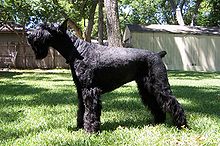Giant Schnauzer
The Giant Schnauzer is a working breed of dog developed in the 17th century in Germany. It is the largest of the three breeds of Schnauzer, with the other two breeds being the Standard Schnauzer and the Miniature Schnauzer. Numerous breeds were used in its development, including the blackGreat Dane, the Bouvier des Flandres, and the Standard Schnauzer. Originally bred to assist on farms by driving livestock to market and guarding the farmer's property, the breed eventually moved into the city, where it worked guarding breweries, butchers' shops, stockyards and factories. It was unknown outside of Bavaria until it became popular as a military dog during World War I and World War II.
They have dense, curly fur that protects them from the weather and from vermin. Giant Schnauzers come in two color patterns: Solid black, and a color known as salt and pepper, where white, black, and gray hairs speckle the dog at random. Where legal, they are shown with cropped ears anddocked tails. Like other schnauzers, they have a distinct beard and eyebrows. Today, the Giant Schnauzer participates in numerous dog sports, including Schutzhund. It is also used as a police dog.
History
The first Giant Schnauzers emerged from Swabia in the German state of Bavaria, and Württemberg in the 17th century.[5][6] These original Giant Schnauzers were considered a rough-coated version of the German pinscher breeds, and their fur was thought to help them withstand the harsh German winters and bites from vermin.[1] The origins of the breed are unclear, but sources speculate it originated through some combination of blackGreat Danes,[1] German Shepherds,[1] Rottweilers,[1] Dobermans,[1] Boxers,[1] Bouvier des Flandres,[1] Thuringian Shepherds,[2] and the Standard Schnauzer.[2]
The Giant Schnauzer was originally bred as a multipurpose farm dog for guarding property and driving animals to market.[7] By the turn of the 20th century the Giant Schnauzer was being used as a watchdog at factories, breweries, butcheries, and stockyards throughout Bavaria.[1][6] It was unknown outside Bavaria until it was used as a military dog in World War I and World War II.[1][6]The first Giant Schnauzers were imported to America in the 1930s, but they remained rare until the 1960s,[8] when the breed became popular. In 1962, there were 23 new Giant Schnauzers registered with the American Kennel Club; in 1974 this number was 386; in 1984 it was over 800 and in 1987 is was around 1000 animals.[9] In 2012, there were 94 new dogs registered, down from 95 in 2011.[10]
In modern times, the Giant Schnauzer is used as a police dog; is trained for obedience, dog agility, herding, search and rescue, and schutzhund; and is shown in conformation shows.[6][8] They are also used for carting.[7] In Europe, the breed is considered to be more of a working dog than a show dog.[9] The focus in many European Schnauzer clubs is not so much on conformation shows, but on the working ability of the breed.[9] In several countries, including Germany, dogs must achieve a Schutzhund Champion title before they can qualify to be a conformation champion.[9]
Description
Appearance
Although the Giant Schnauzer is called 'Giant', this is not in comparison to other large dog breeds such as the Great Dane or the Rottweiler, but instead in comparison to the Standard and Miniature Schnauzers.[1] The AKC breed standard calls for males to stand from 25.5 to 27.5 inches (65 to 70 cm) at the withers, and for females to stand from 23.5 to 25.5 inches (60 to 65 cm).[5] Giant Schnauzers are square in shape,[3] and should resemble a larger version of the Standard Schnauzer.[6]
The tail is always docked where it is legal, and the ears are usually cropped.[3] If the ears are uncropped, they are small button ears carried high on the head.[7] The head is 1/2 the length of the dog's back, when the back is measured from the withers to the base of the tail.[6] The cheeks are flat, but well muscled.[6]
The coat is dense, wiry, and weather resistant.[5][3] The fur on the Giant Schnauzer's face forms a distinct "beard" and eyebrows.[6] Its stride is long and crisp.[2] Giant Schnauzers come in two colors: solid black, and a pattern called salt and pepper, where strands of black, gray, and white fur speckle the dog, giving it the appearance of having been salted and peppered.[5]
Temperament
Giant Schnauzers are usually a quiet breed.[2] Due to its breeding, the Giant Schnauzer is inherently suspicious of strangers and can be very territorial.[1][2] Once introduced, it is usually accepting of novel people or situations.[1] It has the potential to be aggressive,[1] but Giant Schnauzers are usually reserved[2] - they are "amiable in repose, and a commanding figure when aroused"[6]
Giant Schnauzers have been described as trustworthy with children.[2] They are very intelligent, and can become bored easily.[1] They are also very energetic and highly spirited,[6] which, when coupled with boredom, can lead to unwanted and destructive behavior.[1] They are easily trained, and deeply loyal to their owner.[6] Some breeders believe that salt and pepper colored Giant Schnauzers are more docile than their black-furred counterparts.[4]
 | |||||||||||||||||||||||||
| A black Giant Schnauzer groomed for show. | |||||||||||||||||||||||||
| Other names | Munich Schnauzer[1] Munchener[1] Russian Bear Schnauzer[2] | ||||||||||||||||||||||||
|---|---|---|---|---|---|---|---|---|---|---|---|---|---|---|---|---|---|---|---|---|---|---|---|---|---|
| Country of origin | Germany | ||||||||||||||||||||||||
| |||||||||||||||||||||||||
| |||||||||||||||||||||||||



No comments:
Post a Comment